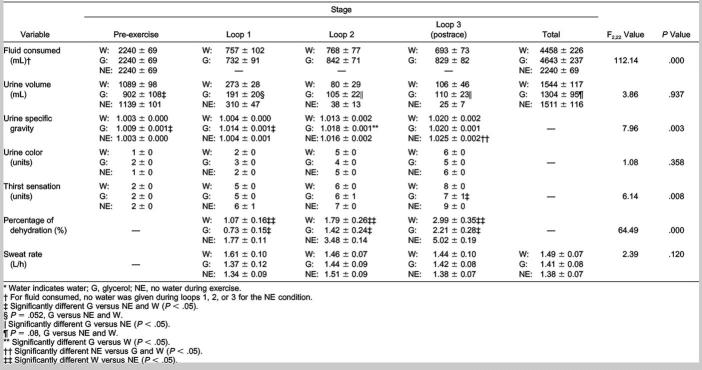Abstract
Objective:
To determine if pre-exercise hydration with and without glycerol differentially affects physiologic and performance responses during mountain-bike races in the heat.
Design and Setting:
Testing (random, crossover, double-blind design) included the following 3 treatments administered in conjunction with a 30-mile mountain-bike race consisting of three 10-mile (16-km) loops: (1) no water during exercise (NE): water consumed before the race and no water consumed during the race, (2) glycerol (G): mixture of water and glycerol consumed before the race and water via 2 water bottles consumed during the race, and (3) water (W): water consumed before the race and water via 2 water bottles consumed during the race. Subjects stopped for 8 minutes after each 10-mile loop for collection of data.
Subjects:
Twelve heat-acclimated male mountain bikers with age = 24.5 ± 1.1 years, percentage of body fat = 14.3 ± 1.0%, mass = 76.9 ± 1.9 kg, height = 179 ± 2 cm.
Measurements:
We measured body weight, percentage of body fat, rectal temperature, blood lactate, blood glucose, urine volume, urine color, urine specific gravity, thirst sensation, thermal sensation, rating of perceived exertion, fluid consumption, heart rate, and sweat rate. Each subject completed the Environmental Symptoms Questionnaire.
Results:
The G trial was less dehydrated than the NE and W trials postexercise. Pre-exercise urine volume was less in the G trial than in the NE and W trials, and postexercise thirst was less in the G trial than the NE and W trials. Postexercise Environmental Symptoms Questionnaire scores were lower in the G trial than the NE or W trials. It is noteworthy that, although not significant, the G trial performed 5 minutes faster on loop 3 than the NE and W trials.
Conclusions:
Lower Environmental Symptoms Questionnaire scores and percentage of dehydration may indicate decreased signs and symptoms of heat strain in the G trial. Based on the NE trial performance, adequate pre-exercise hydration, even without glycerol, may limit the detrimental effects of dehydration.
Keywords: thermoregulation, dehydration, mountain biking, hyperhydration
When athletes compete in hot conditions, adequate hydration is essential to minimize increases in core temperature.1,2 Sawka et al2 have shown that the maximal core temperature tolerated during exercise in uncompensable heat is reduced under conditions of hypohydration. Hence, adequate thermoregulation is, in part, accomplished by sufficient hydration. During exercise heat stress, sweating results in dehydration and compromised thermoregulatory homeostasis unless fluids are replenished at a rate near equal to the volume of fluid lost in sweat. Unfortunately, it is not feasible to replace 100% of the fluid lost in sweat in many athletic and occupational situations.3 For example, rehydration is difficult in long, multifaceted events such as Olympic distance triathlons.4 Additionally, situations that result in high exercise intensities and, hence, high core temperatures can result in high sweat rates and increased fluid loss. Many of these situations may also involve limited access to fluids. Therefore, methods designed to optimize pre-exercise hydration are important and have become the focus of a large body of current research. More specifically, attempting to hyperhydrate pre-exercise is being emphasized in an effort to optimize pre-exercise hydration regimens. Hyperhydration can be defined as a steady-state condition of increased body-water stores.5
Although many pre-exercise hyperhydration protocols are available, ingestion of large quantities of water alone or water mixed with glycerol are the most common methods. Glycerol has been tested as a hyperhydrating agent when used with large volumes of water during pre-exercise hydration periods of 60 to 120 minutes.6 The primary basis for glycerol's use as a hyperhydrating agent is that it increases blood osmolality and, when accompanied by copious amounts of water (1500 to 2000 mL, or 26 mL/kg body weight), provides an osmotic drive that augments retention of large quantities of water otherwise eliminated by the kidneys.7 Glycerol plus water hyperhydration increases total body water when compared with water hyperhydration alone.8–11 Authors have shown conflicting results when assessing the effect of pre-exercise glycerol hyperhydration on subsequent performance and physiologic function. Several groups have shown positive physiologic effects after glycerol ingestion.4,12–16 For instance, Anderson et al12 found that glycerol-beverage ingestion resulted in lower cardiovascular and thermoregulatory strain during subsequent exercise in the heat. Similarly, Montner et al15 discovered lowered heart rates and increased cardiac outputs during ensuing exercise after pre-exercise hydration with a glycerol solution. Other authors have shown positive performance effects after glycerol ingestion. For example, Kavouras et al14 found that cycling time to exhaustion in individuals subjected to a pre-exercise dehydration protocol was longest after a glycerol rehydration protocol compared with water and no-fluid rehydration protocols. Despite these findings, others have shown no benefit of pre-exercise hyperhydration with glycerol compared with hyperhydration with water alone.9,17 Therefore, the National Athletic Trainers' Association has claimed equivocal support for glycerol hyperhydration.18
Methodologic differences may explain discrepancies in previous studies using glycerol hyperhydration. For example, fluid was available during exercise in some of these studies,9,12,17 whereas in others, it was not available.15 Regardless of previous study differences, field-based research is warranted in situations in which rehydration during the actual event is most difficult. The conditions experienced in our study were the epitome of difficulty in hydration: 30 miles ([48 km] three 10-mile loops) of mountain biking in the heat over rough terrain with a long (approximately 3-mile [4.83-km]) hill climb that required frequent changing of gears and intensities. Furthermore, because the study was performed under race conditions with monetary awards for the top finishers, subjects were motivated to maintain as high an intensity as possible in order to compete successfully. Our purpose was to assess if pre-exercise hydration with and without a commercially available glycerol drink affected physiologic and performance responses during mountain-bike races in the heat.
METHODS
Subjects
Twelve male subjects were recruited for this study and, after receiving detailed information, consented to participate in this study, which was approved by the university's institutional review board. Each subject was an experienced mountain biker and was deemed heat acclimatized based on consistent outdoor exposure and exercise (3–4 days per week) in the hot Georgia climate (average daily temperature highs = approximately 30°C to 31.1°C) 1 to 2 months before the start of the study. Physical characteristics of subjects were as follows: age = 24.5 ± 1.1 years, percentage of body fat = 14.3 ± 1.0%, mass = 76.9 ± 1.9 kg, height = 179 ± 2 cm.
Testing Protocol
Figure 1 shows the progression of events that began with subject arrival on experimental testing days. Wet-bulb globe temperature was measured before subject arrival and throughout the day. Baseline hydration status was measured using urine specific gravity (USG). If a subject's USG was less than 1.010 (because he was already hyperhydrated) or greater than 1.025 (because he was dehydrated), he was not tested that day and was rescheduled for a different day. Experimental trials (repeated-measures, random, crossover, double-blind design) were set under race conditions. None of the subjects had consumed glycerol before participating in the study, and in order to ensure that subjects were blind to a pre-exercise fluid treatment, trials were separated by 1 week. Additionally, pre-exercise beverage solutions were flavored with a sugarless solution that masked any potential flavor or texture of the glycerol. Subjects raced for the best time (with the top finishers receiving prize money) over 30 miles (three 10-mile loops) of rough terrain. The difficulty of hydrating while biking on the terrain was demonstrated by the fact that, of 72 loops completed (3 loops per trial, for a total of 108 loops with all subjects combined but only 72 loops in which water was provided) in which water was available during exercise, the water was completely consumed on a single loop only 3 times. Each subject completed 3 trials separated by at least 1 week. Testing included the following 3 treatments: (1) no water during exercise (NE): water equal in volume to 2.8% body weight consumed pre-exercise and no water consumed during the race, (2) glycerol (G): mixture of water (equal in volume to 2.8% body weight) and glycerol (1 g/kg body weight ProHydrator, InterNutria Sports, Framingham, MA) consumed pre-exercise and water via 2 water bottles consumed during the race, and (3) water (W): water equal in volume to 2.8% body weight consumed pre-exercise and water via 2 water bottles consumed during the race. The average temperature of fluid at the start of each loop was 25.40 ± 0.35°C for G and 25.97 ± 0.33°C for W. During each 10-mile loop, 1200 mL of water was available (600 mL per water bottle, 2 water bottles), and 3600 mL of total water was available throughout a trial (enough to keep all subjects at approximately 0% dehydration). After each loop, subjects stopped for 8 minutes while data were collected (Figure 1). No fluid was consumed during this time. Subjects began the next loop with full water stores (if in the G or W trials), which they were instructed to consume ad libitum while riding and without stopping to drink.
Figure 1.
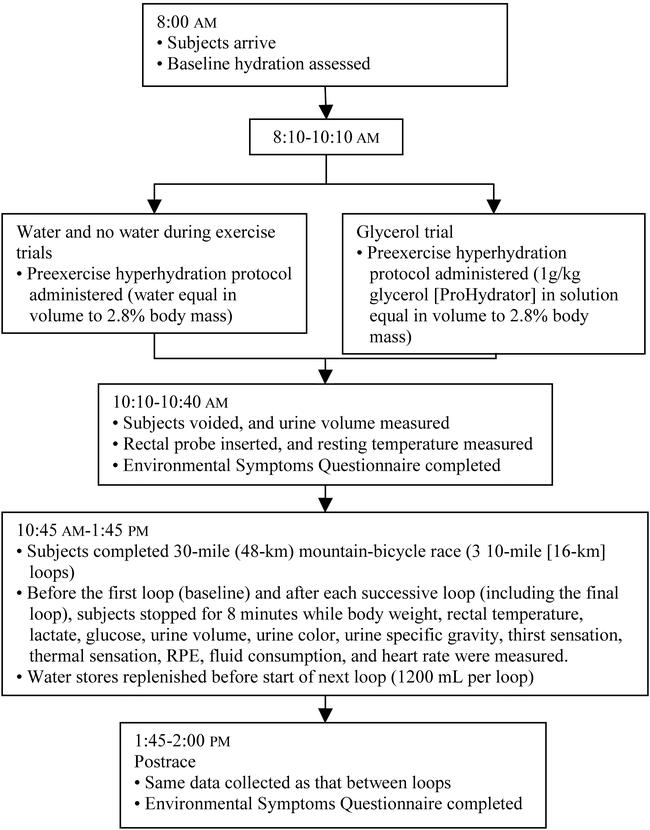
Flow chart representing order of events for all experiments.
Instrumentation
Wet-bulb and dry-bulb temperatures were determined using a sling psychrometer (Bacharach, Inc, Pittsfield, PA), black globe temperature via a homemade device, and wet-bulb globe temperature via a standard calculation.19 Body weights were measured using a Tanita scale (model BWB-800A, Tanita Corp, Tokyo, Japan). Percentage of body fat was measured using a handheld bioelectric impedance analyzer (model HBF-301, Omron, Vernon Hills, IL).20 Rectal temperature was measured using thermistors (model 401, Yellow Springs Instruments, Yellow Springs, OH). Lactate and glucose were measured from whole blood using an Accusport Portable Lactate Analyzer and an Accu-Chek Advantage Portable Glucose Analyzer, respectively (Boehringer Mannheim Corp, Indianapolis, IN). Urine volume was measured by collecting urine into graduated cylinders and then measuring the level.
Urine color was measured using a urine color chart as validated by Armstrong et al.21,22 Urine specific gravity was measured using a refractometer (Atago URICON-NE, Farmingdale, NY). Thirst sensation was assessed using a thirst sensation scale as validated by Riebe et al,23 and thermal sensation was evaluated using a version modified by Toner et al24 of the original scale used by Gagge et al.25 Rating of perceived exertion was measured with the RPE scale developed by Borg.26 Heart rate was measured using Polar heart-rate monitors (Polar Electro, Oy, Finland). Fluid consumed was measured by determining the initial amount given to a subject in a graduated cylinder; when the subject completed a loop, the remaining fluid in the water bottle (if any) was emptied and measured in the graduated cylinder. The difference between the values was the fluid consumed.
Percentage of dehydration was measured as change in body weight from pre-exercise to weight after each loop. Sweat rate was calculated as change in body weight per hour, factoring in exercise time, fluid consumed, and urine volume.
The Environmental Symptoms Questionnaire was developed by Sampson and Kobrick27 and is an index of symptoms related to environmental conditions (headache, nausea, etc).
Statistical Analyses
Variables were analyzed using a 2-way (trial × time) analysis of variance with repeated measures (Statistica, StatSoft, Tulsa, OK). Significant F ratios were analyzed using a Newman-Keuls post hoc test. The level of significance was chosen as α = .05. All data were presented as mean ± SEM.
RESULTS
All trials occurred during similar conditions (wet-bulb globe temperature F2,22 = 0.12, P = .891): NE = 82.7 ± 0.8°C, G = 82.3 ± 0.9°C, and W = 82.9 ± 0.8°C, and Tables 1 and 2 detail the outcome measures. The G trial was less dehydrated than both the NE and W trials for all loops. We found no differences among groups in sweat rate, overall performance time (Table 2 and Figure 2, respectively) (P > .05), or rectal temperature. Rectal temperatures in the W trial significantly decreased from loop 1 to loop 3 and from loop 2 to loop 3.
Table 1.
Thermoregulatory and Physiologic Outcome Measures Associated with Stage of Race (Mean ± SEM)*
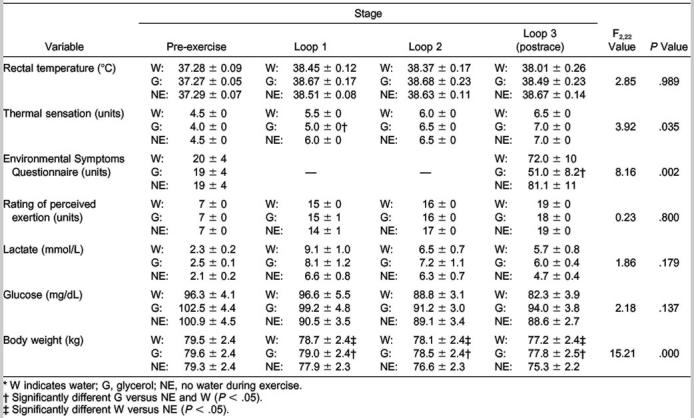
Table 2.
Hydration Outcome Measures Associated with Stage of Race (Mean ± SEM)*
Figure 2.
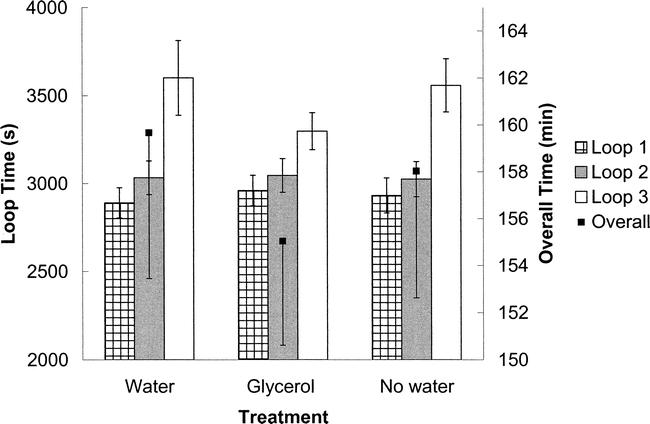
Performance time. No significant differences among treatments were found for overall performance time. F2,20 = 0.867, P = .435.
No differences were found between the W and G trials for blood glucose, blood lactate, rating of perceived exertion, or heart rate (Table 1 and Figure 3, respectively) (P > .05). Overall thermal sensation was less in the G trial than the NE trial (P = .052). Furthermore, perception of thirst was less in the G trial (7 ± 1) compared with the NE (9 ± 0) and W (8 ± 0) postrace (P < .05). Thermal sensation for the G trial (5 ± 0) after loop 1 was significantly lower than for the NE (6 ± 0) or W (5.5 ± 0) trials (P < .05). Postrace scores on the Environmental Symptoms Questionnaire (ESQ) were significantly lower for the G trial (51 ± 8.2) compared with the NE (81.1 ± 11) and W (72 ± 10) trials (P < .05). Although not significantly different, loop 1 urine volume (P = .052) and total urine volume (P = .08) tended to be less in the G trial than in the W trial.
Figure 3.
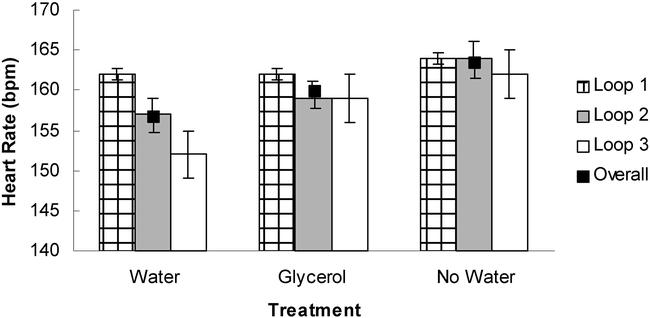
Heart rate. Heart rates provided are the average of 5 points along each 10-mile loop. No significant differences were found within time points across trials. F4,16 = 9.56, P = .000. bpm indicates beats per minute. * Indicates heart rate greater than loops 2 and 3 for the water trial.
DISCUSSION
Physiologic Findings
Our purpose was to determine if pre-exercise hydration with and without glycerol would differentially affect physiologic and performance responses during mountain-bike races in the heat. Glycerol hyperhydration decreased thirst sensation and percentage of dehydration. In addition, loop-1 urine volume was lower in the glycerol trial than in the others and tended to be higher after each of the subsequent loops. Heart rate (Figure 3) and rectal temperature (see Table 1) were not altered during exercise race conditions. Interestingly, rectal temperature dropped during loop 3 of the G and W trials (see Table 1), possibly due to a decrease in intensity during this loop compared with loops 1 and 2. Although not significant, heart rate tended to be lower in the W trial than in the G trial for loops 2 and 3. If plasma volume were expanded during the glycerol treatment because of greater water retention, one would expect heart rate to be lower. However, it is important to note that exercise time and intensity (which would have affected heart rate and rectal temperature) were not controlled because this was a race setting. Therefore, higher intensity (and, hence, higher heart rate) may have been maintainable during the latter stages of the G trial. The shorter performance time (indicating high intensity) during loop 3 of the glycerol trial (see Figure 2) suggests that this was indeed a possibility.
The absence of significant differences in rectal temperature, thermal sensation, urine volume, urine color, and sweat rate may be explained by the availability of water during exercise. Latzka et al28 found that, when fluid was available during exercise, glycerol hyperhydration provided no advantage over euhydration. Equal volumes of fluid were consumed pre-exercise, but urine output was lower during the glycerol trial (see Table 2). This suggests that glycerol increased water retention, thus reducing urine volume. However, water was available ad libitum during the race in the G and W trials. It is possible that any benefit gained from the increased water retention after glycerol ingestion was confounded by the ability to consume water during the race. By being able to drink during the race, subjects may have delayed the negative effects of dehydration caused by exercising in the heat, regardless of whether glycerol was given pre-exercise or not.
Glycerol treatment resulted in lower performance time on loop 3 compared with the NE and W trials, which, although not statistically significant, is consistent with performance benefits associated with glycerol ingestion.4,12,13 If the trend in loop times continued, overall performance time for the NE and W trials would appear to be significantly longer than that for the G trial. The reason for this would most likely not be an attenuation of cardiovascular and thermoregulatory strain (Table 1 illustrates no differences in rectal temperature, and Figure 3 demonstrates no differences in heart rate between the G and W trials) but instead favorable ratings of perceived exertion. Hitchins et al13 postulated improved performance with glycerol concurrent with favorable perceived-exertion ratings among their subjects, thus enabling higher maintainable power outputs with the glycerol treatment. Despite similar perceived-exertion ratings across treatments, Table 2 shows more favorable sensations of thirst after the third loop in the G trial. Similarly, Table 1 demonstrates that the ESQ27 resulted in more favorable scores after the third loop of the G trial. It is, therefore, surmisable that subjects felt better during the late stages of the race in the G trial and that this alteration enabled them to maintain greater intensities, resulting in better performance times on the third loop.
The lack of differences between the G and other trials for overall performance time may have been due to several factors. Perhaps differences in dehydration among the trials were insufficient to translate into noticeable performance differences. Additionally, experimental design features, such as the 8-minute rest intervals between loops, may have enabled some recovery, and the lack of control over exercise time and intensity may have contributed to a lack of differences among performance times.
Interestingly, overall and individual loop times were not different between the NE and W trials during exercise treatments (see Figure 2). The reason for this is uncertain, although we speculate that similar levels of dehydration concurrent with similar levels of perceived exertion (see Tables 1 and 2, respectively) may have contributed to similar performance times during these trials.
Practical Application
The lower thirst sensations, lower ESQ scores, and percentage of dehydration suggest that pre-exercise hydration incorporating glycerol in beverages may offer decreased perception of thermal strain during ensuing exercise in the heat. Furthermore, this study demonstrates the importance of pre-exercise hydration in general in limiting the negative effects of dehydration, especially when it precedes intense, prolonged exercise in the heat. For instance, the NE trial, which involved pre-exercise hydration with water but no water consumption during exercise, resulted in similar rectal temperature and heart rate as other treatments involving water ingestion during exercise. This is similar to the findings of Latzka et al,29 who found that rectal temperature, cardiac output, and sweat rate were not altered between trials completed with either water or a glycerol-water combination pre-exercise and no water consumed during exercise. Despite the lack of fluid during exercise, the sweat rate for our NE trial was similar to the other trials, possibly because of the prerace hyperhydration from the pre-exercise hydration protocol (as indicated by low urine specific gravity; see Table 2). Had subjects not hyperhydrated before each trial, the differences among the NE, G, and W trials might have been statistically significant. This has implications for athletes, coaches, athletic trainers, and others involved in assisting athletes with training and competing in hot conditions where fluid availability may be limited, such as with mountain biking over rough terrain. When it is known that access to fluid may be limited during an event, adequate pre-exercise hydration is important, with or without glycerol, in order to perform optimally and minimize some of the risks associated with heat illness.
Study Limitations
More outcome measures in this study would have been preferable. For instance, if venous blood samples had been drawn, plasma volume changes and plasma osmolality could have been compared among trials. Another limitation to the study is, as mentioned, that the water ingestion during exercise may have confounded the potential benefits of the glycerol pre-exercise hydration. Thus, future research should be conducted with similar pre-exercise glycerol hyperhydration but without water consumption during exercise. If subjects have no access to fluid during exercise, glycerol may create measurable differences in the alleviation or postponement of heat illness when ingested before exercise. In addition, trials with no fluid before but fluid during exercise would provide an interesting comparison with trials involving fluid given only before exercise and might help illustrate the importance of pre-exercise hydration.
CONCLUSIONS
A hydration protocol including glycerol with water before a mountain-bike race in the heat did not differentially affect cardiovascular and thermoregulatory responses or performance time compared with pre-exercise hydration without glycerol. However, we did find enhanced fluid retention with glycerol ingestion pre-exercise and more favorable sensations of thirst and environmental symptoms scores postexercise with glycerol. Additionally, pre-exercise hydration, even without glycerol, provided some benefit in terms of limiting the effects of dehydration. This suggests that, when fluid availability is limited during exercise, adequate pre-exercise hydration is important in enabling athletes to compete optimally and safely.
ACKNOWLEDGMENTS
We thank the 12 dedicated subjects who gave such an incredible effort for the races. Also, we are thankful for invaluable assistance provided by Tutita Casa, Dayna Hoffman, Charlie Mattox, and Antoine Simmons.
REFERENCES
- 1.Murray R. Dehydration, hyperthermia, and athletes: science and practice. J Athl Train. 1996;31:248–252. [PMC free article] [PubMed] [Google Scholar]
- 2.Sawka MN, Young AJ, Latzka WA, Neufer PD, Quigley MD, Pandolf KB. Human tolerance to heat strain during exercise: influence of hydration. J Appl Physiol. 1992;73:368–375. doi: 10.1152/jappl.1992.73.1.368. [DOI] [PubMed] [Google Scholar]
- 3.Convertino VA, Armstrong LE, Coyle EF, et al. American College of Sports Medicine position stand: exercise and fluid replacement. Med Sci Sports Exerc. 1996;28:i–vii. doi: 10.1097/00005768-199610000-00045. [DOI] [PubMed] [Google Scholar]
- 4.Coutts A, Reaburn P, Mummery K, Holmes M. Olympic distance triathlon performance in high ambient temperatures. Int J Sport Nutr Exerc Metab. 2002;12:105–119. doi: 10.1123/ijsnem.12.1.105. [DOI] [PubMed] [Google Scholar]
- 5.Casa DJ. Exercise in the heat, I: fundamentals of thermal physiology, performance implications, and dehydration. J Athl Train. 1999;34:246–252. [PMC free article] [PubMed] [Google Scholar]
- 6.Wagner DR. Hyperhydrating with glycerol: implications for athletic performance. J Am Diet Assoc. 1999;99:207–212. doi: 10.1016/s0002-8223(99)00049-8. [DOI] [PubMed] [Google Scholar]
- 7.Robergs RA, Griffin SE. Glycerol: biochemistry, pharmacokinetics and clinical and practical applications. Sports Med. 1998;26:145–167. doi: 10.2165/00007256-199826030-00002. [DOI] [PubMed] [Google Scholar]
- 8.Lyons TP, Riedesel ML. Glycerol-induced hyperhydration: its effects on fluid compartments in the rat. Life Sci. 1993;53:1779–1787. doi: 10.1016/0024-3205(93)90165-y. [DOI] [PubMed] [Google Scholar]
- 9.Magal M, Webster MJ, Sistrunk LE, Whitehead MT, Evans RK, Boyd JC. Comparison of glycerol and water hyperhydration regimens on tennis-related performance. Med Sci Sports Exerc. 2003;35:150–156. doi: 10.1097/00005768-200301000-00023. [DOI] [PubMed] [Google Scholar]
- 10.Koenigsberg PS, Martin KK, Hlava HR, Riedesel ML. Sustained hyperhydration with glycerol ingestion. Life Sci. 1995;57:645–653. doi: 10.1016/0024-3205(95)00316-x. [DOI] [PubMed] [Google Scholar]
- 11.Riedesel ML, Allen DY, Peake GT, Al-Qattan K. Hyperhydration with glycerol solutions. J Appl Physiol. 1987;63:2262–2268. doi: 10.1152/jappl.1987.63.6.2262. [DOI] [PubMed] [Google Scholar]
- 12.Anderson MJ, Cotter JD, Garnham AP, Casley DJ, Febbraio MA. Effect of glycerol-induced hyperhydration on thermoregulation and metabolism during exercise in heat. Int J Sport Nutr Exerc Metab. 2001;11:315–333. doi: 10.1123/ijsnem.11.3.315. [DOI] [PubMed] [Google Scholar]
- 13.Hitchins S, Martin DT, Burke L, et al. Glycerol hyperhydration improves cycle time trial performance in hot humid conditions. Eur J Appl Physiol Occup Physiol. 1999;80:494–501. doi: 10.1007/s004210050623. [DOI] [PubMed] [Google Scholar]
- 14.Kavouras SA, Casa DJ, Herrera JA, et al. Rehydration with glycerol: endocrine, cardiovascular, and thermoregulatory effects during exercise in 37°C. Med Sci Sports Exerc. 1998;30:S332. [Google Scholar]
- 15.Montner P, Stark DM, Riedesel ML, et al. Pre-exercise glycerol hydration improves cycling endurance time. Int J Sports Med. 1996;17:27–33. doi: 10.1055/s-2007-972804. [DOI] [PubMed] [Google Scholar]
- 16.Scheett TP, Webster MJ, Wagoner KD. Effectiveness of glycerol as a rehydrating agent. Int J Sport Nutr Exerc Metab. 2001;11:63–71. doi: 10.1123/ijsnem.11.1.63. [DOI] [PubMed] [Google Scholar]
- 17.Inder WJ, Swanney MP, Donald RA, Prickett TC, Hellemans J. The effect of glycerol and desmopressin on exercise performance and hydration in triathletes. Med Sci Sports Exerc. 1998;30:1263–1269. doi: 10.1097/00005768-199808000-00013. [DOI] [PubMed] [Google Scholar]
- 18.Casa DJ, Armstrong LE, Hillman SK, et al. National Athletic Trainers' Association position statement: fluid replacement for athletes. J Athl Train. 2000;35:212–224. [PMC free article] [PubMed] [Google Scholar]
- 19.Armstrong LE, Epstein Y, Greenleaf JE, et al. American College of Sports Medicine position stand: heat and cold illnesses during distance running. Med Sci Sports Exerc. 1996;28:i–x. [PubMed] [Google Scholar]
- 20.Loy SF, Likes E, Andrews P, et al. Easy grip on body composition measurements: three labs show accuracy of hand-held fat analyzer. ACSM Health Fitness J. 1998;2:16–19. [Google Scholar]
- 21.Armstrong LE, Maresh CM, Castellani JW, et al. Urinary indices of hydration status. Int J Sport Nutr. 1994;4:265–279. doi: 10.1123/ijsn.4.3.265. [DOI] [PubMed] [Google Scholar]
- 22.Armstrong LE, Herrera-Soto J, Hacker FT, Jr, Casa DJ, Kavouras SA, Maresh CM. Urinary indices during dehydration, exercise, and rehydration. Int J Sport Nutr. 1998;8:345–355. doi: 10.1123/ijsn.8.4.345. [DOI] [PubMed] [Google Scholar]
- 23.Riebe D, Maresh CM, Armstrong LE, et al. Effects of oral and intravenous rehydration on ratings of perceived exertion and thirst. Med Sci Sports Exerc. 1997;29:117–124. doi: 10.1097/00005768-199701000-00017. [DOI] [PubMed] [Google Scholar]
- 24.Toner MM, Drolet LL, Pandolf KB. Perceptual and physiological responses during exercise in cool and cold water. Percept Mot Skills. 1986;62:211–220. doi: 10.2466/pms.1986.62.1.211. [DOI] [PubMed] [Google Scholar]
- 25.Gagge AP, Stolwijk JAJ, Hardy JD. Comfort and thermal sensations and associated physiological responses at various ambient temperatures. Environ Res. 1967;1:1–20. doi: 10.1016/0013-9351(67)90002-3. [DOI] [PubMed] [Google Scholar]
- 26.Borg GA. Perceived exertion. Exerc Sport Sci Rev. 1974;2:131–153. [PubMed] [Google Scholar]
- 27.Sampson JB, Kobrick JL. The Environmental Symptoms Questionnaire: revisions and new field data. Aviat Space Environ Med. 1980;51:872–877. [PubMed] [Google Scholar]
- 28.Latzka WA, Sawka MN, Montain SJ, et al. Hyperhydration: thermoregulatory effects during compensable exercise-heat stress. J Appl Physiol. 1997;83:860–866. doi: 10.1152/jappl.1997.83.3.860. [DOI] [PubMed] [Google Scholar]
- 29.Latzka WA, Sawka MN, Montain SJ, et al. Hyperhydration: tolerance and cardiovascular effects during uncompensable exercise-heat stress. J Appl Physiol. 1998;84:1858–1864. doi: 10.1152/jappl.1998.84.6.1858. [DOI] [PubMed] [Google Scholar]



